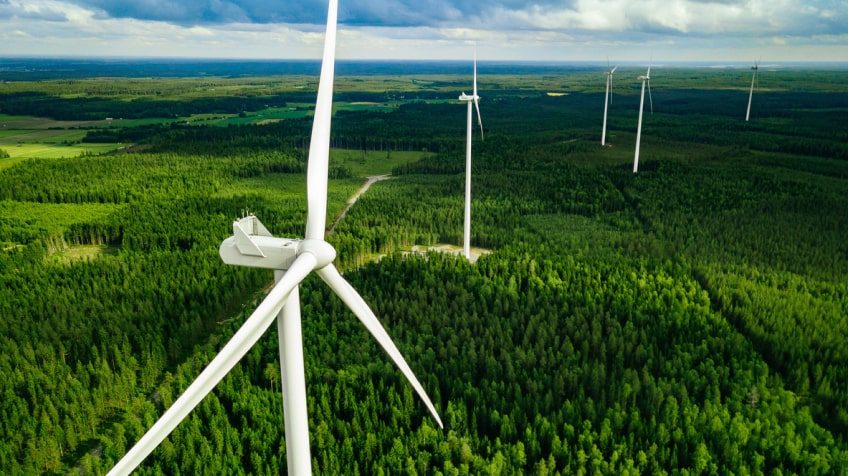Technology is the driving force behind most sustainability efforts.
According to Allied Market Research, the global sustainable technology market size was valued at around $9 billion in 2019, but is projected to reach $48.36 billion by 2027, a growth rate of 24.3% over seven years. Green tech environmental solutions powered by artificial intelligence (AI), machine learning (ML), the Internet of Things (IoT), big data, natural language processing (NLP), edge computing, and robotic process automation, are all currently protecting the very environment that made evolution possible in the first place.
For example, AI is a key component of complex data analysis and management within sustainable decision making, especially in areas like climate change, air/water quality, disaster resilience, and biodiversity conservation.
In this blog post, we’ll explore seven examples of sustainable technology implementations that show us what the future may look like.
Electric vehicles and public electric transport
Electric vehicles have been in development for quite a while, but their ongoing evolution fascinates us. Modern car batteries are a great sustainable energy solution, especially now with prolonged lifespans. On the other hand, the advancement of self-driving technology and the growth of charging station infrastructures are a better glimpse into the future of transportation. They enable more accurate, streamlined and safer electric vehicle ecosystems.
Tesla, for example, features a reliable autopilot mode capable of driving its passengers to desired destinations with minimal human interference.
Public electric transport has also been improving rapidly.
As electric vehicles become more accessible, municipalities around the globe are implementing electric vehicles and smart navigation systems. In Chinese cities, there are over 400,000 electric buses currently in use, making the country one of the leaders in adopting sustainable technology.
The main downside of implementing public electric transport is the high acquisition price of EVs, but this challenge is mitigated when we take the long view and realize that the total cost of ownership (TCO) of EVs is actually lower as these vehicles are not fuel dependent. When we take into consideration that e-Buses eliminate air emissions such as sulfur oxides (SOx), nitrogen oxides (NOx), and carbon dioxide (CO2), the benefits are even more clear.
Accessible solar power
Green tech solutions like solar-powered renewable energy are getting cheaper, easier to implement, and more accessible.
With the solar power grid expanding across the globe, major cities in developed countries are not the only areas benefiting from solar power. Less developed countries are also adopting renewable solutions that allow underdeveloped municipalities to bring electricity quickly and cheaply to where it is needed the most.
This type of environmental technology, coupled with innovative financing plans, helps make accessible and affordable smart solutions like Solar Home Systems (SHS) available in communities that are too far from a reliable grid connection. SHS is estimated to help power over 150 million households, and with the average cost of solar PV panels dropping more than 70% over the last seven years.
Carbon capture and storage
It’s not enough to focus merely on decarbonizing the industries that create cement and plastics. Businesses need to invest in capturing the carbon that is being emitted during production and do it safely. This is where sustainable technology like carbon capture and storage (CCS) comes into play. CCS enables industries to:
- Capture carbon at its source
- Compress the captured carbon
- Move the captured carbon to a suitable permanent storage site
This green tech solution can significantly reduce greenhouse gas emissions while making room for more revenue if the captured CO2 is used in the creation of other products. Numerous industries are already implementing this method. Plastics manufacturers use captured carbon to make their products – polyurethane, for example. Also, emerging technologies, such as direct air capture, are now affordable enough to be done at scale.
Hydrogen use in energy transition
Hydrogen is playing a key role in meeting ambitious global warming benchmarks. Hydrogen is expected to power over 400 million cars by 2050, including 20 million buses and over 20% of passenger ships and locomotives.
Even though battery-powered EVs currently feature higher fuel efficiency when compared to hydrogen, hydrogen-powered fuel cells can store more energy per weight metric. This ability is expected to make EV batteries more suitable for heavy cargo vehicles that travel long distances.
Vehicles powered by hydrogen-powered fuel cells are already being used in Japan, South Korea, California, and Germany. According to Wiki, as of December 2020, there were 31,225 passenger FCEVs powered with hydrogen on the world’s roads. South Korea is the country with the most passenger FCEVs (10,041 units), followed by the United States (9,135), China (5,546), and Japan (4,100). Greentech environmental prediction for hydrogen fuel is that it could be crucial in decreasing carbon dioxide emissions by 60%.
LED light efficiency
Energy-efficient LED lighting is on its way to completely replace traditional incandescent bulbs. This sustainable energy solution is expected to achieve an 84% market share across the US and reduce energy consumption by 40% by 2030.
That translates to $26 billion in savings adjusted to today’s energy prices. These cost savings could rise even more, as the Department of Energy claims an additional 20% cost reduction with the increased investment in LED lights.
Sustainable technology in healthcare
The healthcare industry is slowly but surely taking a leading role in cost-efficiency and the use of sustainable technology.
The use of healthcare facilities with solar rooftops is on the rise, and because they are among the biggest energy consumers today, it is critical that the healthcare industry implements as many green tech environmental and sustainable technologies as possible.
Big hospitals are increasingly introducing eco-friendly solutions for managing and minimizing medical waste, while smaller health facilities are also turning to scalable waste reduction solutions. Admittedly, with healthcare accounting for 4.4% of global emissions, there is still room for improvement.
Plastic recycling
Currently, 260 million tons of plastic waste is generated across the globe every year. However, only 16% of it gets recycled.
The plastics industry has started adopting circular models to prevent enormous amounts of plastic waste. One circular approach is pyrolysis, which is a sustainable way to generate energy from waste. In essence, pyrolysis uses heat and the absence of oxygen to reconvert plastic waste back into liquid feedstock.
Another process, called chemical recycling, has been an alternative to traditional recycling for years. It is an attempt to recycle the unrecyclable. Instead of a traditional recycling system where some plastics are rejected because they are made of composites or are the wrong color, chemical recycling can register all types of plastic that would then unmake plastics back into oil, which could be used to make plastic again. This creates an infinite loop of plastic creation.
Building a sustainable future together
Not only are green tech and sustainable technologies here to stay, but they are also our biggest asset for keeping our environment healthy without slowing down tech evolution.
However, implementing sustainable technologies within a business’s infrastructure can be counter-productive in terms of cost-effectiveness if experienced industry experts do not manage the process.
Want to learn more about how HTEC’s technology expertise can transform your business? Explore our Technical Strategy and Logistics & Transportation capabilities.




